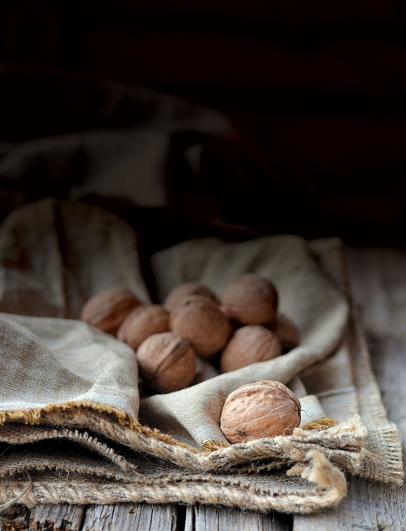Walnuts, Almonds and Pistachios: Year-Round Favorites at their Peak in Winter
Walnuts, almonds and pistachios, all major crops in California, have a place in my pantry year round, but they are especially good in winter, just after the new crop has been harvested and their fresh, nutty flavor is intense.
I use them in salads, cookies and cakes and always include a handful with a cheese platter, along with dried fruit—another winter pantry staple.
I live surrounded by walnut and almond orchards, and even have a few trees of my own, so it gives me extra pleasure when I see local nuts in the markets. It’s like they are my own grown children, having watched them mature from their early leafing out in spring, to clusters of green nuts, to the moment of harvest.
In September and October I start anticipating the new crop of nuts as I see the shakers moving into the orchards. The strange-looking machines remind me of World War I submarines I once saw in the military museum in London, low to the ground with long front ends and the driver encased in a cage. However, unlike the submarines, the shakers have a long arm and a clamp that grabs and violently shakes the trees, sending nuts cascading to the ground. A sweeper follows, piling the nuts in long windrows where they dry for several days before the harvester comes through and picks them all up. The freshly harvested nuts are then taken to processors to be cleaned, sized and, for most of them, shelled before sale.
In 1969, new to the Napa Valley, my husband got some sage advice from Al Wurz, whose family was farming large blocks of Napa ground: “Stay diversified,” Al told him. “Spread your risk. Keep a third of your ground in grapes, a third in prunes and a third in walnuts.”
That year Napa County had 12,000 acres of grapes and 4,600 acres of prunes and Sonoma County had 12,000 acres of grapes and 16,000 acres of prunes. Walnuts covered 1,200 acres in Sonoma and Napa had a few hundred acres. That was before shakers, so the prunes were handpicked and the almonds and walnuts were knocked down with long sticks.
Walnuts and almonds both came to California with the Franciscan fathers in the 1700s, and were planted in missions up and down the state. In 1848, Florentine Kellogg made a planting of walnuts in his nursery not far from St. Helena. By the late 1800s and well into the early 1960s, there were substantial walnut plantings in Napa and Sonoma counties, although the major production area early on was Southern California. As housing demands increased in Southern California, walnut production moved to California’s Central Valley.
And, in Napa and Sonoma, as the wine grape production became increasingly lucrative, Mr. Wurz’s sage advice no longer seemed so useful and much of the walnut and prune ground was turned to grapes.
Last year, the grape crop in Napa was worth $656 million and in Sonoma $582 million. Sonoma still had 26 acres of prunes and 119 acres of walnuts. Napa has so few walnuts and prunes remaining that the Agricultural Commissioner doesn’t even count them as separate crops.
But, elsewhere in California, which produces 99% of the US walnut supply and 75% of the world crop that is traded, walnuts are big business.
Last year’s crop was 497,000 tons and more than 280,000 acres are planted to walnuts. I am very glad they are still around.
WALNUT AND ALMOND TART
This tart is my version of the ones I find in the patisseries of Provence during the winter, perfect with a late afternoon cup of coffee or tea, or for dessert, perhaps, topped with whipped cream.
Yield: 10–12 servings
INGREDIENTS FOR THE PASTRY
1 1/2 cups flour
1/4 cup sugar
1/4 cup butter, cut into 1/2-inch chunks
1 large egg
INGREDIENTS FOR THE FILLING
2 tablespoons butter, melted and cooled
1/2 cup firmly packed light brown sugar
2 large eggs
1/2 cup Cointreau (optional)
1-inch piece of vanilla bean
1 1/2 cups walnut and almond meats, coarsely chopped and lightly toasted
TO PREPARE THE PASTRY
Preheat oven to 350°F.
In a bowl, combine the flour and the sugar and stir to mix well. Add the butter and work it in with your fingertips until the mixture becomes crumb-like. Add the egg and, with a fork, mix it well. Tightly pack the dough into a ball. Using your fingers, press the dough evenly into a 9-inch tart pan with a removable bottom, reaching to the top of the rim. Set aside.
TO PREPARE THE FILLING
In a bowl, combine the melted butter, brown sugar, eggs and optional Cointreau and stir to mix well. Slit the vanilla bean and scrape the soft inner lining of the vanilla bean into the bowl, discarding the pod. Stir until well blended. Stir in the nuts and pour the filling into the tart pan. Do not over fill.
Bake until the crust and the filling are golden brown, about 50 minutes. Transfer to a rack to cool. With the tip of a knife, loosen the edges of the crust, then remove the pan rim and slide the tart onto a plate. Serve warm or at room temperature.




